
only for part of the day.
(Photos © J. Maus/BikePortland)
This post is part of ongoing coverage from Europe. Read more stories from my trip here.
You might have a perception that everyone bikes in Copenhagen, or that the City has carte blanche to put cycle tracks and bike parking wherever they please. It turns out that’s not exactly true.
Copenhagen has some of the same problems we do: Such as finding space for bikes when cars need space too. As the number of people who bike goes up, so does competition for road space. And there are still many people in Copenhagen (a growing number actually) who prefer to drive. A few days ago I met Niels Hoe, a consultant who formerly managed the City of Copenhagen’s bicycle parking program. Hoe shared an interesting concept called “flex parking”.
At issue was an extreme lack of bicycle parking space at Ingrid Jespersen High School in the Østerbro district. Directly in front of the school are five auto parking spaces. With dozens and dozens of families that ride to the school each day, there wasn’t enough bike parking to go around. As a result, bikes were everywhere and the sidewalk was a cluttered mess. This is where Hoe comes in. He fashions himself as an expert on the “dynamic use of road space”. That is, he has lots of experience fitting bicycles into a constrained urban environment (he’s currently on contract with the City to map locations for their bike share stations coming this fall). “It’s a school so it needs a lot of bicycle space during certain hours,” Hoe explained, “but after school hours cars need the space.”
The solution Hoe helped devise was to make the space work for cars and bikes. Between the hours of 7:00 am and 5:00 pm on weekdays the space is for bicycles only. Cars can park in the spaces during all other hours and on the weekends. To make the spaces work, the City added blue pavement markings, and signage on the sidewalk and on banners that hang on the wall of the school that faces the street (both are very inexpensive). Police enforcement has also been a part of this project. They issue fines for people who park cars in the space during school hours. On the bike side of things, it’s the school’s responsibility to make sure there are no bikes left after 5:00 pm. (If there are, they can simply pick them up and put them on the sidewalk.)
This is a classic compromise, says Hoe, because people who bike don’t get the benefit of an actual rack (you need a kickstand to use it), and people who drive are only allowed to use the space for limited hours. “Bikes get an 80% solution; but it’s also not ideal for cars,” is how he puts it.
I visited the site on Friday morning and saw a bustling scene. Bikes lined the racks that are attached to the school wall adjacent to the sidewalk and the flex parking area was nearly full. I couldn’t imagine how crowded the sidewalk must have been before this was put in place.
Thomas Westergaard-Kabelmann, who has a 1st grader at the school, told me that, “It was chaos” before the flex parking. It was especially difficult, he said, to park cargo bikes like his. He seemed really pleased with the solution. He also shared that this is part of a “gradual cultural shift” that has been going on in Copenhagen for the past 5-10 years as people begin to embrace bicycling and realize its popularity demands changes in how public space is designed.
Hoe says the City tried this as an experiment (they do that a lot) two years ago and it has worked so well the concept has been expanded to four other schools. You can learn more about Hoe’s work on flex parking and his many other innovative ideas on his website. He will also be a presenter at the upcoming Velo City conference in Vienna later this month.
— Read more of our coverage from Copenhagen here.




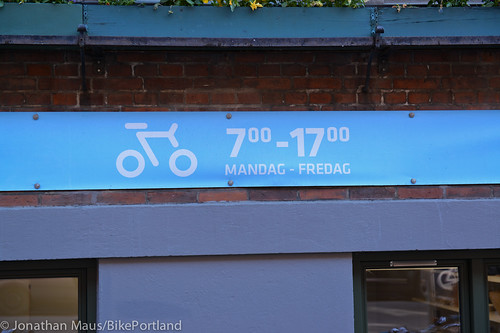
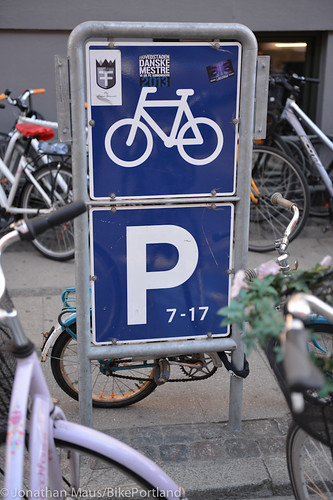


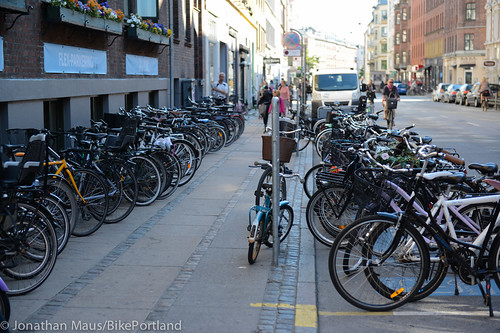
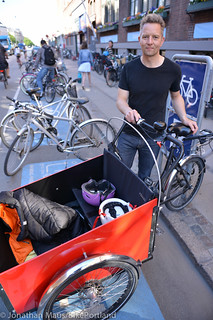

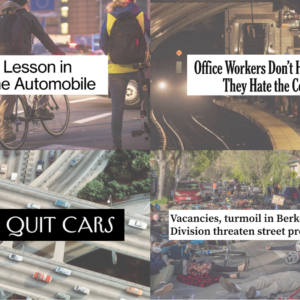

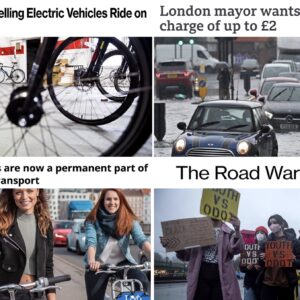
I’m curious, how are the people securing their bikes in these spaces exactly? Is bike theft non-existent there?
Ah good question John. Bike theft definitely exists here. I got my rental bike stolen as a matter of fact! But my bike wasn’t locked at all (not even the wheel)… And the vast majority of people just lock their bike to itself without locking it to something planted into the ground. And this is a school in a high-visibility area so I’m sure it’s fine.
Ouch.
A story about bike theft and how Danes deal with it would be a nice addition to your excellent coverage on the infrastructure and cultural aspects of their country.
Seems like a bike thief buffet, doesn’t it? Just pick up a bike, hang it on a car rack, gone in 10 seconds, cut the lock at your leisure. At least that is what would happen here.
When I was in Copenhagen, I noticed that most bikes had the lock built into the bike; it was attached to the seat stay (linking to the rear hub) and wrapped around the rear tyre. While not impossible to remove, it is a bit different to your average cable/U-bolt lock.
Not exactly true. Visit the USC campus in LA. Thousands of bikes, all locked to themselves
My Breezer comes with a Cafe Lock (locks the frame to the rear wheel) and I use it often in the Boston area, though not for an all day type parking thing. Yes somebody could pick it up but the likelihood of somebody coming by with a pickup that is looking for bikes and is able to pick it up (all 40+ pounds of it) and throw it in the truck is very very unlikely. If it were a cargo bike near impossible without a small team, of course more people means more attention making it is less likely. This is a great solution that works well in this space! To copy something like this in the US where most folks do not have Cafe Locks something like a folding bollard could be used that is upright when used as bike parking and folds into a groove in the pavement when used for auto parking. A bit more complicated but could work in very specific areas.
Hi John_on_central
Nice with a reflection on the lock/theft issue. All to offen good Idea’s get “rejected” or chritizsed. You have a cool and balanced perspective to how to park a bike (cafe lock for short term day/u lock ect for long or overnight). Same way I do it.
But don’t copy the Flex-parking. Get the original with modifications. I’m the one that developed the concept and toke it through texting and now implement it at more locations in Denmark.
I had many considerations about foldable racks as you mention. But budget did’t allow it. So went with the kickstand solution. Would love to see a more advance version come true.
I had a cafe lock (or frame lock) on my last bike and it was immensely convenient to use it to just lock in place, particularly if I was going to be eating at a cafe in plain site of the bike. It would prevent ride aways, and I’d be close enough to chase down anyone that picked it up physically. It also had a plug in chain that I regularly used to secure to objects or to make an island of friends’ bikes that would be impossible to move (without a forklift). But the frame lock is heavy and the chain was even more weight. Still, immensely utilitarian.
“As the number of people who bike goes up, so does competition for road space.”
Really? I’d have thought that although this could be how (some) people still in cars see it, in fact, because bikes take up so much less space either in motion or parked, that the opposite would be true.
Of course, 9watts, considering the sheer scale of the number of bikes that fit into a relatively short linear distance of street, it is a selling point! I can’t really tell from the photos, but based on Portland’s 10 bikes per auto parking space, plus sidewalk, perhaps 50 bikes fit into the space that 5 cars took up plus another 50 on the sidewalk? (Yes, the sidewalk is narrower with all those bikes parked there, but there is still a walking ‘lane’). That is impressive! (good luck finding those riding numbers at the good ol’ USA’s high schools anymore, by the way)
Pro-time parking, why didn’t we think of that?
Actually in the US “temporal” parking exists but widespread use is limited to roadway capacity…think of those Portland arterials which allow curbside parking except for peak periods for commuter flows. And a rare use for cafe expansions with permits into parking areas, such as in Mountain View, CA.